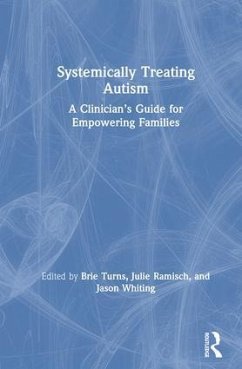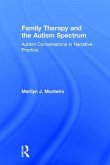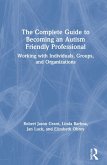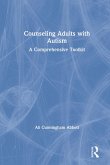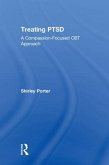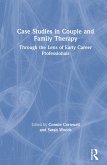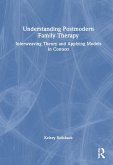Systemically Treating Autism
A Clinician's Guide for Empowering Families
Herausgeber: Turns, Brie; Whiting, Jason B; Ramisch, Julie
Systemically Treating Autism
A Clinician's Guide for Empowering Families
Herausgeber: Turns, Brie; Whiting, Jason B; Ramisch, Julie
- Gebundenes Buch
- Merkliste
- Auf die Merkliste
- Bewerten Bewerten
- Teilen
- Produkt teilen
- Produkterinnerung
- Produkterinnerung
Systemically Treating Autism provides a unique resource for family therapists and other mental health professionals who want to increase their understanding of families with children with autism spectrum disorder (ASD).
Andere Kunden interessierten sich auch für
![Family Therapy and the Autism Spectrum Family Therapy and the Autism Spectrum]() Marilyn J MonteiroFamily Therapy and the Autism Spectrum197,99 €
Marilyn J MonteiroFamily Therapy and the Autism Spectrum197,99 €![The Complete Guide to Becoming an Autism Friendly Professional The Complete Guide to Becoming an Autism Friendly Professional]() Robert Jason GrantThe Complete Guide to Becoming an Autism Friendly Professional187,99 €
Robert Jason GrantThe Complete Guide to Becoming an Autism Friendly Professional187,99 €![Counseling Adults with Autism Counseling Adults with Autism]() Ali Cunningham AbbottCounseling Adults with Autism165,99 €
Ali Cunningham AbbottCounseling Adults with Autism165,99 €![Treating Ptsd Treating Ptsd]() Shirley PorterTreating Ptsd189,99 €
Shirley PorterTreating Ptsd189,99 €![Gentle Parenting Reimagined Gentle Parenting Reimagined]() Paul SunseriGentle Parenting Reimagined150,99 €
Paul SunseriGentle Parenting Reimagined150,99 €![Case Studies in Couple and Family Therapy Case Studies in Couple and Family Therapy]() Case Studies in Couple and Family Therapy186,99 €
Case Studies in Couple and Family Therapy186,99 €![Understanding Postmodern Family Therapy Understanding Postmodern Family Therapy]() Kelsey RailsbackUnderstanding Postmodern Family Therapy189,99 €
Kelsey RailsbackUnderstanding Postmodern Family Therapy189,99 €-
-
-
Systemically Treating Autism provides a unique resource for family therapists and other mental health professionals who want to increase their understanding of families with children with autism spectrum disorder (ASD).
Hinweis: Dieser Artikel kann nur an eine deutsche Lieferadresse ausgeliefert werden.
Hinweis: Dieser Artikel kann nur an eine deutsche Lieferadresse ausgeliefert werden.
Produktdetails
- Produktdetails
- Verlag: Taylor & Francis
- Seitenzahl: 244
- Erscheinungstermin: 4. März 2019
- Englisch
- Abmessung: 229mm x 152mm x 16mm
- Gewicht: 513g
- ISBN-13: 9781138306578
- ISBN-10: 1138306576
- Artikelnr.: 56895450
- Herstellerkennzeichnung
- Libri GmbH
- Europaallee 1
- 36244 Bad Hersfeld
- gpsr@libri.de
- Verlag: Taylor & Francis
- Seitenzahl: 244
- Erscheinungstermin: 4. März 2019
- Englisch
- Abmessung: 229mm x 152mm x 16mm
- Gewicht: 513g
- ISBN-13: 9781138306578
- ISBN-10: 1138306576
- Artikelnr.: 56895450
- Herstellerkennzeichnung
- Libri GmbH
- Europaallee 1
- 36244 Bad Hersfeld
- gpsr@libri.de
Brie Turns, PhD, LMFT-A is an assistant professor at Fuller Theological Seminary-Arizona and provides clinical treatment to families raising a child with autism spectrum disorder at the Family Christian Counseling Center. Julie Ramisch, PhD, LMFT is the director of Coastal Center for Collaborative Health where she offers counseling, supervises other therapists, and authors publications about working with families with children with autism spectrum disorder. Jason Whiting, PhD, LMFT is a professor at Brigham Young University where he researches conflict and challenges in families. He is the author of books and blogs to help strengthen couples.
Introduction SECTION I: Understanding Autism Spectrum Disorders Chapter 1:
A Century of Autism: The Story of the Diagnosis Chapter 2: It's a Wide the
Spectrum: Understanding the Characteristics and Tendencies of ASD Chapter
3: It May Not Be ASD: Distinguishing Autism Spectrum Issues from Other
Diagnoses SECTION II: Autism, The Family, and The Wider Community Chapter
4: The Parental Subsystem: The Effects of Raising a Child with ASD Chapter
5: How to Assist and Empower Parents Raising a Child with ASD Chapter 6:
The Sibling Subsystem: The Effects of Being Raised with an Individual with
ASD Chapter 7: Providing Resources for Neurotypical Siblings of Children
with ASD Chapter 8: Autism and Society: How ASD Influences the Extended
Family and Society SECTION III: Applying Systemic Theories Chapter 9: The
Use of Solution-Focused Brief Therapy with Families Chapter 10: Focusing on
Emotions of Couples: Tailoring Emotionally Focused Therapy to Couples with
Children with ASD Chapter 11: Using Bowen Family Systems Theory with
Families Chapter 12: Decoding the Puzzle of Fairness: Using Contextual
Family Therapy with Families Chapter 13: Parent-Child Interaction Therapy
with Families SECTION V: ASD through the Lifespan Chapter 14: Empowering
Parents After a Recent Diagnosis Chapter 15: Empowering Families During
Early and Middle Childhood Chapter 16: Empowering Families Transitioning
into High School Chapter 17: Empowering Families Transitioning into Early
Adulthood Chapter 18: Empowering Families Deciding Between Home or
Placement and Coping with Placement Decisions Chapter 19: Assisting the
Family After Divorce or Separation SECTION VI: Special Topics Chapter 20:
Arranging an Appropriate Therapeutic Environment Chapter 21: Spirituality
and the Family Unit Chapter 22: Caregiver and Professional
Perspectives: From Financial Planning Obstacles to Optimizing the Future
Chapter 23: Evidence-Based Practices Chapter 24: It Takes a Village:
Collaborating with Mental Health Professionals Chapter 25: Helping the
Family Communicate with Technology Chapter 26: Self-Compassion and Raising
a Child with ASD
A Century of Autism: The Story of the Diagnosis Chapter 2: It's a Wide the
Spectrum: Understanding the Characteristics and Tendencies of ASD Chapter
3: It May Not Be ASD: Distinguishing Autism Spectrum Issues from Other
Diagnoses SECTION II: Autism, The Family, and The Wider Community Chapter
4: The Parental Subsystem: The Effects of Raising a Child with ASD Chapter
5: How to Assist and Empower Parents Raising a Child with ASD Chapter 6:
The Sibling Subsystem: The Effects of Being Raised with an Individual with
ASD Chapter 7: Providing Resources for Neurotypical Siblings of Children
with ASD Chapter 8: Autism and Society: How ASD Influences the Extended
Family and Society SECTION III: Applying Systemic Theories Chapter 9: The
Use of Solution-Focused Brief Therapy with Families Chapter 10: Focusing on
Emotions of Couples: Tailoring Emotionally Focused Therapy to Couples with
Children with ASD Chapter 11: Using Bowen Family Systems Theory with
Families Chapter 12: Decoding the Puzzle of Fairness: Using Contextual
Family Therapy with Families Chapter 13: Parent-Child Interaction Therapy
with Families SECTION V: ASD through the Lifespan Chapter 14: Empowering
Parents After a Recent Diagnosis Chapter 15: Empowering Families During
Early and Middle Childhood Chapter 16: Empowering Families Transitioning
into High School Chapter 17: Empowering Families Transitioning into Early
Adulthood Chapter 18: Empowering Families Deciding Between Home or
Placement and Coping with Placement Decisions Chapter 19: Assisting the
Family After Divorce or Separation SECTION VI: Special Topics Chapter 20:
Arranging an Appropriate Therapeutic Environment Chapter 21: Spirituality
and the Family Unit Chapter 22: Caregiver and Professional
Perspectives: From Financial Planning Obstacles to Optimizing the Future
Chapter 23: Evidence-Based Practices Chapter 24: It Takes a Village:
Collaborating with Mental Health Professionals Chapter 25: Helping the
Family Communicate with Technology Chapter 26: Self-Compassion and Raising
a Child with ASD
Introduction SECTION I: Understanding Autism Spectrum Disorders Chapter 1:
A Century of Autism: The Story of the Diagnosis Chapter 2: It's a Wide the
Spectrum: Understanding the Characteristics and Tendencies of ASD Chapter
3: It May Not Be ASD: Distinguishing Autism Spectrum Issues from Other
Diagnoses SECTION II: Autism, The Family, and The Wider Community Chapter
4: The Parental Subsystem: The Effects of Raising a Child with ASD Chapter
5: How to Assist and Empower Parents Raising a Child with ASD Chapter 6:
The Sibling Subsystem: The Effects of Being Raised with an Individual with
ASD Chapter 7: Providing Resources for Neurotypical Siblings of Children
with ASD Chapter 8: Autism and Society: How ASD Influences the Extended
Family and Society SECTION III: Applying Systemic Theories Chapter 9: The
Use of Solution-Focused Brief Therapy with Families Chapter 10: Focusing on
Emotions of Couples: Tailoring Emotionally Focused Therapy to Couples with
Children with ASD Chapter 11: Using Bowen Family Systems Theory with
Families Chapter 12: Decoding the Puzzle of Fairness: Using Contextual
Family Therapy with Families Chapter 13: Parent-Child Interaction Therapy
with Families SECTION V: ASD through the Lifespan Chapter 14: Empowering
Parents After a Recent Diagnosis Chapter 15: Empowering Families During
Early and Middle Childhood Chapter 16: Empowering Families Transitioning
into High School Chapter 17: Empowering Families Transitioning into Early
Adulthood Chapter 18: Empowering Families Deciding Between Home or
Placement and Coping with Placement Decisions Chapter 19: Assisting the
Family After Divorce or Separation SECTION VI: Special Topics Chapter 20:
Arranging an Appropriate Therapeutic Environment Chapter 21: Spirituality
and the Family Unit Chapter 22: Caregiver and Professional
Perspectives: From Financial Planning Obstacles to Optimizing the Future
Chapter 23: Evidence-Based Practices Chapter 24: It Takes a Village:
Collaborating with Mental Health Professionals Chapter 25: Helping the
Family Communicate with Technology Chapter 26: Self-Compassion and Raising
a Child with ASD
A Century of Autism: The Story of the Diagnosis Chapter 2: It's a Wide the
Spectrum: Understanding the Characteristics and Tendencies of ASD Chapter
3: It May Not Be ASD: Distinguishing Autism Spectrum Issues from Other
Diagnoses SECTION II: Autism, The Family, and The Wider Community Chapter
4: The Parental Subsystem: The Effects of Raising a Child with ASD Chapter
5: How to Assist and Empower Parents Raising a Child with ASD Chapter 6:
The Sibling Subsystem: The Effects of Being Raised with an Individual with
ASD Chapter 7: Providing Resources for Neurotypical Siblings of Children
with ASD Chapter 8: Autism and Society: How ASD Influences the Extended
Family and Society SECTION III: Applying Systemic Theories Chapter 9: The
Use of Solution-Focused Brief Therapy with Families Chapter 10: Focusing on
Emotions of Couples: Tailoring Emotionally Focused Therapy to Couples with
Children with ASD Chapter 11: Using Bowen Family Systems Theory with
Families Chapter 12: Decoding the Puzzle of Fairness: Using Contextual
Family Therapy with Families Chapter 13: Parent-Child Interaction Therapy
with Families SECTION V: ASD through the Lifespan Chapter 14: Empowering
Parents After a Recent Diagnosis Chapter 15: Empowering Families During
Early and Middle Childhood Chapter 16: Empowering Families Transitioning
into High School Chapter 17: Empowering Families Transitioning into Early
Adulthood Chapter 18: Empowering Families Deciding Between Home or
Placement and Coping with Placement Decisions Chapter 19: Assisting the
Family After Divorce or Separation SECTION VI: Special Topics Chapter 20:
Arranging an Appropriate Therapeutic Environment Chapter 21: Spirituality
and the Family Unit Chapter 22: Caregiver and Professional
Perspectives: From Financial Planning Obstacles to Optimizing the Future
Chapter 23: Evidence-Based Practices Chapter 24: It Takes a Village:
Collaborating with Mental Health Professionals Chapter 25: Helping the
Family Communicate with Technology Chapter 26: Self-Compassion and Raising
a Child with ASD

